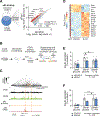Repression of latent NF-κB enhancers by PDX1 regulates β cell functional heterogeneity
- PMID: 38171340
- PMCID: PMC10793877
- DOI: 10.1016/j.cmet.2023.11.018
Repression of latent NF-κB enhancers by PDX1 regulates β cell functional heterogeneity
Abstract
Interactions between lineage-determining and activity-dependent transcription factors determine single-cell identity and function within multicellular tissues through incompletely known mechanisms. By assembling a single-cell atlas of chromatin state within human islets, we identified β cell subtypes governed by either high or low activity of the lineage-determining factor pancreatic duodenal homeobox-1 (PDX1). β cells with reduced PDX1 activity displayed increased chromatin accessibility at latent nuclear factor κB (NF-κB) enhancers. Pdx1 hypomorphic mice exhibited de-repression of NF-κB and impaired glucose tolerance at night. Three-dimensional analyses in tandem with chromatin immunoprecipitation (ChIP) sequencing revealed that PDX1 silences NF-κB at circadian and inflammatory enhancers through long-range chromatin contacts involving SIN3A. Conversely, Bmal1 ablation in β cells disrupted genome-wide PDX1 and NF-κB DNA binding. Finally, antagonizing the interleukin (IL)-1β receptor, an NF-κB target, improved insulin secretion in Pdx1 hypomorphic islets. Our studies reveal functional subtypes of single β cells defined by a gradient in PDX1 activity and identify NF-κB as a target for insulinotropic therapy.
Keywords: IL-1β; NF-κB; PDX1; chromatin; circadian; diabetes; inflammation; insulin; p65; β cells.
Copyright © 2023 The Authors. Published by Elsevier Inc. All rights reserved.
Conflict of interest statement
Declaration of interests M.P. is currently affiliated with Ionis Pharmaceuticals, Inc.
Figures




References
Publication types
MeSH terms
Substances
Grants and funding
- F31 DK130589/DK/NIDDK NIH HHS/United States
- R01 DK090625/DK/NIDDK NIH HHS/United States
- P30 CA060553/CA/NCI NIH HHS/United States
- R01 DK113011/DK/NIDDK NIH HHS/United States
- R01 AG065988/AG/NIA NIH HHS/United States
- P30 DK020595/DK/NIDDK NIH HHS/United States
- P30 DK020593/DK/NIDDK NIH HHS/United States
- F30 DK116481/DK/NIDDK NIH HHS/United States
- R01 DK127800/DK/NIDDK NIH HHS/United States
- R01 DK050203/DK/NIDDK NIH HHS/United States
- P01 AG011412/AG/NIA NIH HHS/United States
- U24 DK059637/DK/NIDDK NIH HHS/United States
LinkOut - more resources
Full Text Sources
Molecular Biology Databases
Research Materials

